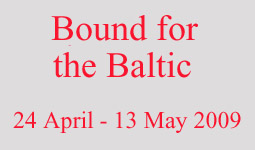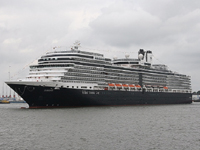Page 1 2 3 4 5 6 7 8 9 10 11 12 Saturday, 2 May (p.m.). Our tour to Sete Cidades left at 12:30. The island of Sao Miguel apparently was formed by two volcanoes whose lava flows eventually connected them. So there is a large volcano on each end of the island, and there was a tour to each of them. We had chosen the tour to Sete Cidades on the west side, said to be one of the most beautiful natural settings in the Azores. It's the most popular national park in the islands.
The road began climbing almost as soon as we left the city. The lush green scenery was beautiful. Soon we could see both the north and south coasts of the island. There were numerous lava domes formed by volcanic action, most of them long covered by vegetation.
Eventually we came within sight of the lakes (or lake) for which the area is
famous. They lie 1,500 feet below the rim of a volcanic crater about three
miles across. There is really only one body of water,
but it has a narrow neck near the center, spanned by a bridge. On one
side of the bridge the water reflects the sky and therefore appears blue; on the
other side it reflects the vegetation on sides of the crater and therefore
appears green. At least that's what's supposed to happen on a clear, sunny day.
Although we had quite a bit of sun by now, the skies were still mostly cloudy,
and our guide was warned us that we might not see the phenomenon.
As it turned out, though, we could see the two colors, at least from certain
angles.
The bus wound its way down the steep road to the small village of Sete Cidades (pop. <900). (That means Seven Cities, but there is only the one village.) We got off the bus near a bandstand in what was probably the village's main square, and we had about 45 minutes to explore on our own. There was a little church nearby and an even smaller chapel across the street. Most of the houses were very small. The village men were erecting some kind of log structure, probably temporary for some festival from the looks of it.
Leaving the village, our bus crossed the bridge that divided the lake, then headed up the steep incline to the road near the lip of the caldera. From here we had a spectacular view of the village, both lakes, and the rim of the caldera opposite where we were.
The bus then took us back to Ponta Delgada where we visited a
pineapple "plantation." We were surprised to see that the pineapples were grown
in green houses and that they were much smaller than the pineapples we were used
to. Equally surprising was their strong, sweet flavor. Pineapples were
introduced here about 1850 as a replacement crop for the oranges for which the
Azores were famous. (The Azores lost the market to other growers after the
islands'orange trees were destroyed by a disease.)
We got back to the Eurodam about 3:30 and the ship sailed at 4:50. That evening there was a movie (Frost/Nixon) in the MainStage at 8:45 instead of a live show, and we watched that. | ||||||||||||||||



